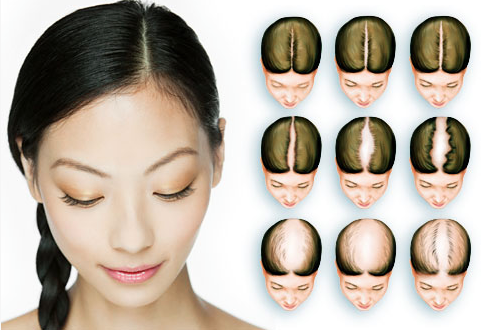Hair loss is a common problem that affects both men and women, but it can be especially distressing for women. Female hair loss can have a significant impact on a woman’s self-esteem and confidence, leading many to wonder if their hair will ever grow back.
The good news is that in many cases, female hair loss can grow back. However, the process can be slow and requires patience and dedication to a healthy hair care routine. In this article, we will explore the causes of female hair loss, the options for treatment, and the steps you can take to encourage hair growth.
Click here to find the best products:
Can female hair loss grow back?Restoring Female Hair Loss: Is it Possible?
Female hair loss can be a distressing experience, and it is estimated that around 40% of women will experience some degree of hair loss by the age of 50. Fortunately, there are several options available for restoring hair loss in women, depending on the cause and severity of the condition.
Causes of Female Hair Loss
There are several potential causes of hair loss in women, including genetics, hormonal imbalances, and medical conditions. Androgenetic alopecia, or female pattern baldness, is the most common form of hair loss in women and is caused by a genetic predisposition to hair follicle sensitivity to androgens. Hormonal imbalances, such as those caused by pregnancy, menopause, or thyroid disorders, can also lead to hair loss in women. Medical conditions such as alopecia areata, scalp infections, and trichotillomania can also cause hair loss.
Treatments for Female Hair Loss
The right treatment for female hair loss will depend on the underlying cause of the condition. For androgenetic alopecia, medications such as minoxidil and finasteride can be effective in slowing or stopping hair loss. Hair transplant surgery may also be an option for some women. Hormonal imbalances can often be treated with hormone replacement therapy or other medications. For medical conditions such as alopecia areata, corticosteroids or other immunosuppressive medications may be used.
Lifestyle Changes for Hair Health
While medical treatments can be effective for restoring hair loss in women, there are also several lifestyle changes that can help promote healthy hair growth. A balanced diet with plenty of protein, vitamins, and minerals can help support healthy hair growth. Regular exercise and stress management techniques can also help promote healthy hair growth by reducing inflammation and improving circulation to the scalp.
Conclusion
While female hair loss can be a distressing experience, there are several options available for restoring hair growth. The right treatment will depend on the underlying cause of the condition, and a combination of medical treatments and lifestyle changes may be necessary for optimal results.
10 Effective Ways to Reverse Female Hair Loss – A Comprehensive Guide
Female hair loss can be a frustrating and embarrassing problem to deal with. While it’s normal to shed around 50-100 hairs per day, anything beyond that can be a cause for concern. Fortunately, there are several effective ways to reverse female hair loss. In this comprehensive guide, we’ll cover 10 of the most effective ways to combat hair loss in women.
1. Identify the underlying cause: Female hair loss can be caused by a variety of factors, including genetics, hormonal imbalances, stress, and certain medical conditions. Before you start any treatment, it’s important to identify the underlying cause of your hair loss.
2. Use minoxidil: Minoxidil is an over-the-counter topical medication that has been approved by the FDA to treat hair loss. It works by increasing blood flow to the hair follicles, which can stimulate growth. Apply it twice a day to your scalp.
3. Take hair growth supplements: Supplements containing biotin, iron, and vitamin D can help promote hair growth and prevent hair loss.
4. Ditch tight hairstyles: Tight hairstyles like braids, ponytails, and cornrows can put stress on your hair follicles and cause hair loss. Opt for looser styles that don’t pull on your hair.
5. Avoid heat styling: Heat styling tools like hair dryers, flat irons, and curling irons can damage your hair and cause it to break. Try to limit your use of these tools, or use them on a lower heat setting.
6. Try laser therapy: Low-level laser therapy can help stimulate hair growth and prevent further hair loss. It’s a painless treatment that involves using a special device to deliver light to your scalp.
7. Use essential oils: Essential oils like lavender, peppermint, and rosemary have been shown to promote hair growth and prevent hair loss. Mix a few drops with a carrier oil like coconut oil and massage into your scalp.
8. Eat a healthy diet: A balanced diet rich in protein, vitamins, and minerals is essential for healthy hair growth. Eat plenty of fruits, vegetables, lean proteins, and whole grains.
9. Reduce stress: Stress can contribute to hair loss by disrupting your hormone levels and causing inflammation. Try to find ways to reduce stress, such as meditation, yoga, or exercise.
10. Consider hair transplant surgery: Hair transplant surgery involves taking hair follicles from one area of your scalp and transplanting them to another. It’s a more invasive option, but it can be effective for those with severe hair loss.
There you have it – 10 effective ways to reverse female hair loss. Remember, everyone’s hair loss is different, so what works for one person may not work for another. Be patient and persistent, and don’t hesitate to seek the advice of a healthcare professional if your hair loss persists.
Female Hair Loss: Will Hair Grow Back from the Roots?
Female hair loss is a common condition that affects women of all ages. Losing hair can be a stressful experience, and many women wonder if their hair will grow back from the roots. In this article, we will explore the causes of female hair loss, the chances of regrowth, and some ways to promote hair growth.
Causes of Female Hair Loss
Female hair loss can be caused by a variety of factors, including genetics, hormonal changes, medications, and medical conditions. Androgenetic alopecia or female pattern baldness is the most common cause of hair loss in women. This condition is caused by a combination of genetic and hormonal factors.
Other medical conditions that can cause hair loss in women include thyroid disorders, autoimmune diseases like alopecia areata, and scalp infections. Certain medications like chemotherapy drugs, blood thinners, and antidepressants can also cause hair loss.
Will Hair Grow Back from the Roots?
The chances of hair regrowth depend on the underlying cause of hair loss. In cases of androgenetic alopecia, hair loss is permanent and cannot be reversed. However, in cases of temporary hair loss caused by medication or medical conditions, hair can grow back once the underlying condition is treated or the medication is stopped.
It’s important to note that hair regrowth can take time and may not be immediate. It can take several months for hair to start growing back and up to a year for noticeable regrowth.
Ways to Promote Hair Growth
While there is no guaranteed way to promote hair growth, there are some things you can do to support healthy hair growth. These include:
- Eating a balanced diet: A diet rich in vitamins and minerals like iron, biotin, and zinc can support healthy hair growth.
- Reducing stress: Stress can trigger hair loss, so finding ways to manage stress like exercise, meditation, or therapy can be beneficial for hair health.
- Using hair growth products: There are many hair growth products on the market like shampoos, conditioners, and serums that claim to promote hair growth. While not all of these products are effective, some may help support healthy hair growth.
- Avoiding tight hairstyles: Tight hairstyles like braids, ponytails, and buns can cause hair breakage and damage, so it’s best to avoid them or wear them loosely.
Conclusion
Female hair loss can be a stressful experience, but in many cases, hair can grow back from the roots. The chances of regrowth depend on the underlying cause of hair loss, and it’s important to address any medical conditions or medications that may be causing hair loss. Supporting healthy hair growth through diet, stress management, and hair growth products can also be beneficial for hair health.
Thickening Thin Hair in Females: Is it Possible?
Are you struggling with thin hair and looking for ways to make it look thicker? You are not alone. Many females have thin hair due to genetics, aging, or other factors. The good news is that there are several ways to increase the volume and thickness of thin hair.
1. Use volumizing shampoos and conditioners
Look for shampoos and conditioners that are specifically formulated for thin hair. These products contain ingredients that can help add volume and thickness to your hair, making it appear fuller and healthier.
2. Try hair thickening products
There are several hair thickening products available in the market, such as thickening sprays, mousses, and serums. These products contain ingredients that coat the hair strands, making them appear thicker and fuller.
3. Get a haircut
The right haircut can make a huge difference in the appearance of thin hair. Ask your hairstylist for a layered cut that adds volume and texture to your hair. Avoid blunt cuts that can make your hair look even thinner.
4. Use hair extensions
Hair extensions can be a great way to add volume and thickness to your hair. There are several types of extensions available, including clip-ins, tape-ins, and sew-ins. Consult with a professional stylist to find the best type of extension for your hair.
5. Change your diet
Your diet can have a significant impact on the health and thickness of your hair. Eating a balanced diet with plenty of protein, vitamins, and minerals can help promote hair growth and thickness. Foods that are rich in biotin, such as eggs, nuts, and whole grains, can be particularly beneficial for thin hair.
6. Consider medication
If your thin hair is due to a medical condition, such as hypothyroidism or alopecia, medication may be necessary to treat the underlying issue. Consult with a healthcare professional to determine the best treatment plan for your condition.
Thickening thin hair in females is possible with the right products and techniques. Experiment with different methods to find what works best for your hair type and lifestyle.
Female hair loss is a common condition that can be caused by various factors. However, the good news is that hair loss in women can grow back with proper treatment and care. It’s important to identify the underlying cause of hair loss and seek medical advice from a dermatologist. With the right diagnosis and treatment, female hair loss can be reversed, and hair can grow back to its former glory. Don’t lose hope, take action, and start your journey towards regaining your beautiful and healthy hair.


